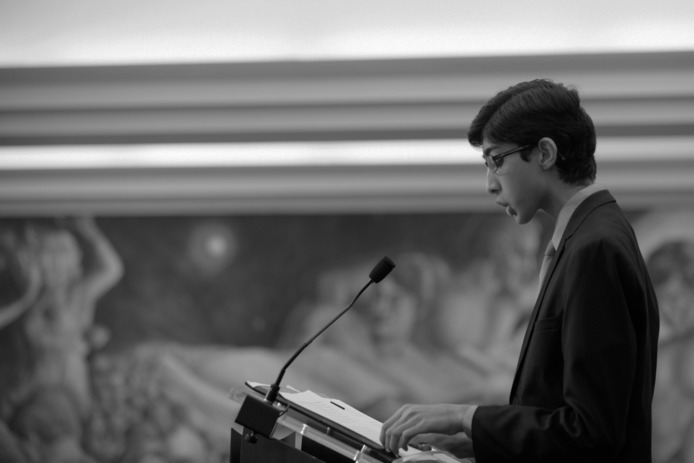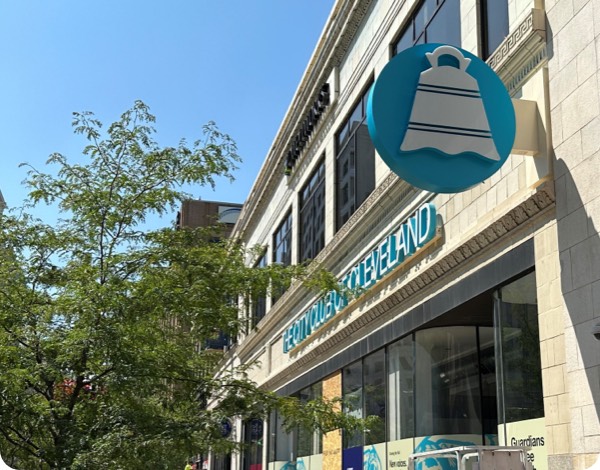Wednesday, June 06, 2018
Speakers of the People, for the People, by the People

by Shruthi Ravichandran, Hathaway Brown School, 9th/10th Grade 2018 Hope and Stanley Adelstein Free Speech Essay Contest Winner
A speaker stands at the podium. Students turn their backs and began to chant loudly enough to drown out the speaker. A mob throws a smoke bomb. Others stand up with placards and megaphones. This scene has been playing out at many different colleges, universities, and other institutions across the country. As the political climate has become more polarized, institutions’ invitations of controversial speakers have been met with indignation and even antagonism on the part of community members. This has led to violent protests and raised many questions regarding institutions’ roles in these protests. On the one hand, the Constitution grants the right to free speech and protests, and these students should be allowed to express their feelings against the speakers. On the other hand, our nation relies on free thought and speech; when protests get so loud that they threaten the speakers’ right to freedom of expression, this results in narrow-minded thinking. It is the responsibility of the institution to refer to its institutional values and democratically decide to whom to offer their stage. A democratic decision ensures that the voices representing the community are heard without restricting freedom of speech or expression.
In the past year, conflict regarding ideology has arisen in many universities across the US. For example, in March 2017, Charles Murray, a political scientist, was engaged to speak at Middlebury College. In 1994, Murray had published a book that tried to explain the socio-economic gap between white and black Americans as because of differences in intelligence levels. Owing to this problematic stance, he had not even uttered ten words when the audience stood up, turned its back on him, and began chanting, “Your message is hatred; we will not tolerate it.”
A similar incident ensued at Claremont McKenna, a small liberal-arts college in Southern California. Heather Mac Donald, a scholar from the Manhattan Institute, who was perceived by students as an “Anti-Black Fascist”, was invited to speak at the college. Undergraduate students targeted her, claiming that she was a white supremacist who “disputed the right of black people to exist.” Students physically blocked entrances and breached safety parameters, resulting in suspensions and punishments from the administration of the school. This, in turn, angered those who felt that these students were simply exercising their constitutional rights and protesting.
With these kinds of protests occurring more frequently across the country, it is essential that institutions develop a protocol for deciding to whom they provide a public platform. Institutional values, core values used in decision-making and in measuring the success of actions taken by the establishment, should be prioritized when identifying speakers to engage for establishments’ audience. Aligning with values does not mean political ideology, for that would create an echo chamber and narrow the minds of students and listeners. Rather, institutions should engage speakers who share similar values with respect to human morals and ethics. In our increasingly-divided world, institutions must foster open dialogue.
In its core values statement, Middlebury states that it “aims to provide a sense of belonging to all students” and that it “respect[s] our community, our co-workers, and the environment.” Inviting a speaker such as Murray goes against this, as Murray’s views were anti-black and demeaned a large portion of the student body. By making sure that speakers align with the institutional values, rather than just the views of a small subset of the community, institutions can aim to engage speakers that appeal to a larger portion of their students while also having a diverse set of backgrounds, not limited by political ideology.
The most effective way to choose perspectives representative of those in the community is to allow those in opposition a chance to voice their opinions against the speaker prior to engagement. Often, in the current process, speakers are chosen behind closed doors. Making the process more transparent would reduce discontentment among protestors that their opinion was not heard or valued. Institutions, when in the process of engaging a speaker, should be open to the views of the student body. Instead of only considering the opinions of the administrative entities when deciding whom to invite, which was what happened in the Middlebury case, institutions ought to alert the community of potential speakers. They should then solicit the views of those with strong negative opinions - those who would protest. If the percentage of the community who opposes the speaker is more than half, the institution ought not to provide the platform to the speaker, both to represent the voices of the community and to avoid immediate shutdown of the speaker. Inviting someone more moderate may help expand thinking more than inviting someone so radical they may not be heard. This simple democratic process would “weed out” speakers with whom the community may not align. Such a democratic process would protect freedom for both entities and allow the voices of those in opposition to be heard.
As Americans, as members of a community, the choice is in our hands. Our country was founded on the principles of tolerance and broadening our horizons with new ideas and inputs. At this point, the ball is in our court. Will we choose to listen to opposing points of views, or will we stand in protest? As this choice lies in the hands of each member of the community, it is the institution’s duty to provide an open but safe and controlled environment that allows all to express their points of view without infringing upon others’ safety or views. To do this, institutions must look to the values they were founded upon, rather than being swayed by political parties or people. With this, they should democratically poll the community to see the points of view of those who may potentially be opposing the speaker. In doing so, institutions can encourage dialogue while remaining true to their values and protecting the right of speech and expression for all.
This year’s 9th/10th grade winner of the 2018 Hope and Stanley Adelstein Free Speech Essay contest expounded on the following prompt.
"In the past year, college campuses from Berkeley to Middlebury have seen widespread student protests against speakers brought to their respective campuses. While many contend that students are exercising their right to protest, others argue that student protests have reached the point where they now drown out the voices they disagree with. This debate is not limited to educational settings; here at the City Club, we saw community members speaking both in favor and in opposition of Corey Lewandowski speaking from our stage. With these opposing perspectives in mind, how should institutions determine to whom they provide a public platform?"





